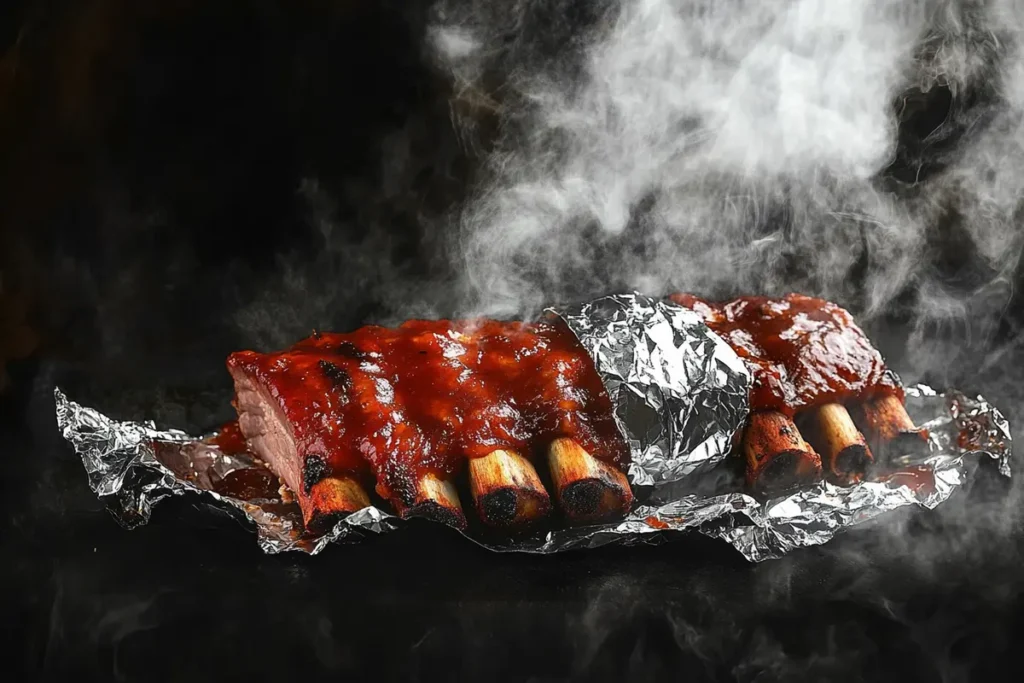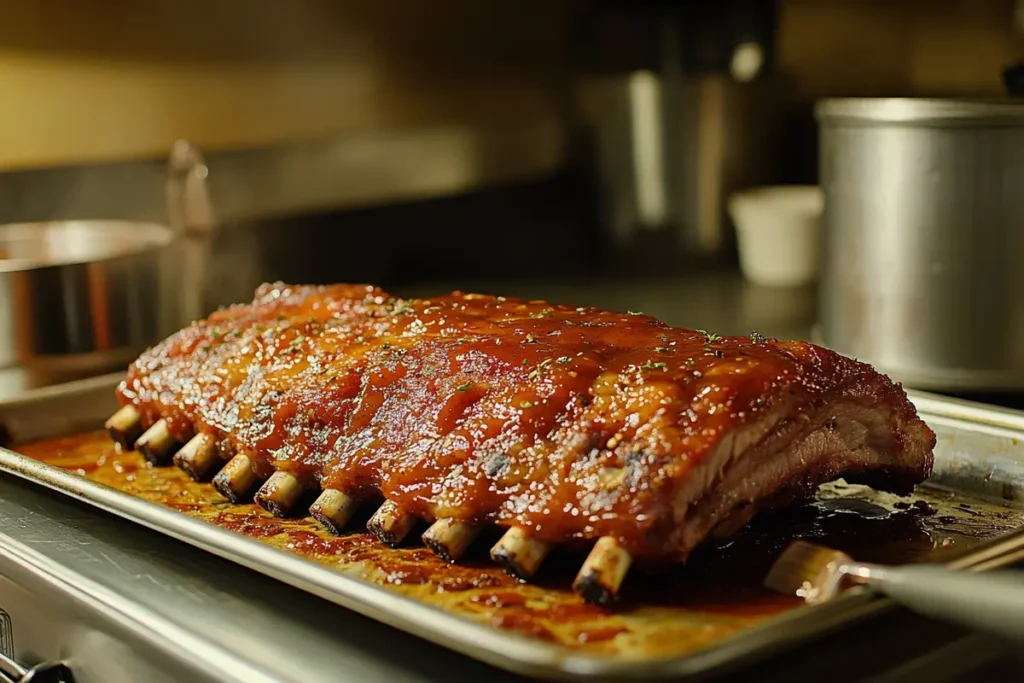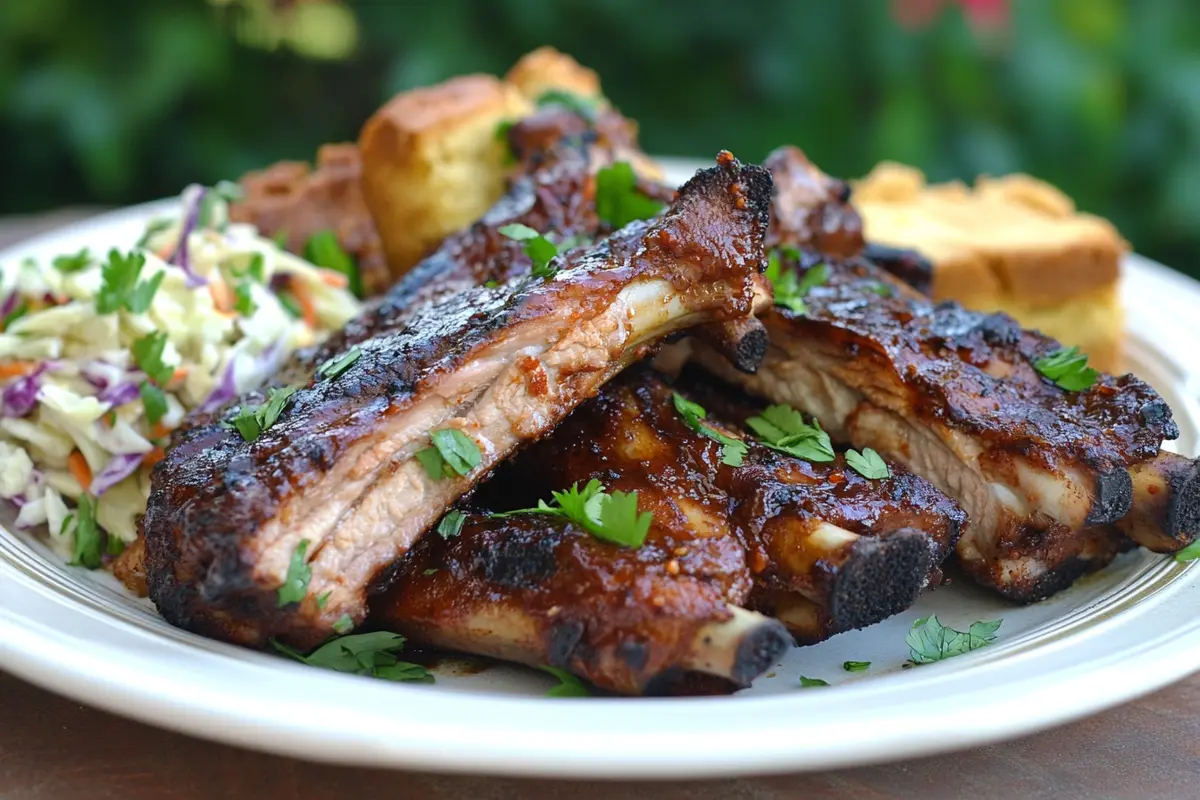Introduction to Best Cooking Methods for Back Ribs
Cooking back ribs to perfection is both an art and a science. With so many cooking methods available, from grilling to sous vide, choosing the right one can be overwhelming. Each technique has its own set of benefits, influencing flavor, tenderness, and ease of preparation. This article dives into the most popular ways to cook back ribs, comparing their strengths and shortcomings, so you can decide which suits your taste and occasion. Whether you’re a fan of the smoky barbecue experience or the ease of slow cooking, there’s a method for everyone. Let’s dig in, starting with an overview of what makes back ribs special.
Table of Contents
Understanding Back Ribs
Definition and Anatomy of Back Ribs
Back ribs, often referred to as baby back ribs, come from the upper portion of a pig’s ribcage, near the spine. Unlike spare ribs, which are larger and tougher, back ribs are smaller, more curved, and tender. These ribs are prized for their leaner meat and the way they cook evenly, making them perfect for various cooking methods.
Nutritional Value and Popularity
Why are back ribs so popular? For one, they strike a balance between flavor and health. Back ribs are lower in fat compared to other cuts, yet they remain juicy and flavorful when cooked properly. Their versatility makes them a staple in cuisines worldwide, from smoky barbecues to slow-cooked feasts.
Importance of Cooking Methods for back ribs
Impact on Flavor and Texture
Cooking techniques have a profound effect on how back ribs taste and feel. Grilling, for instance, imparts a smoky char, while oven-baking ensures an even cook and seals in moisture. Smoking adds depth, while sous vide creates unparalleled tenderness. Selecting the right method can elevate your ribs from good to unforgettable.
Health Considerations
Not all methods are created equal when it comes to health. Techniques like grilling can introduce potential carcinogens if done improperly, while oven-baking and slow cooking retain more nutrients. Knowing the strengths and pitfalls of each approach ensures that you enjoy your back ribs guilt-free.
Popular Best Cooking Methods for Back Ribs
Grilling Back Ribs: Best cooking methods
Direct vs. Indirect Grilling
Grilling back ribs offers two primary approaches: direct and indirect heat. Direct grilling involves placing the ribs directly over the flames, cooking them quickly and creating a rich char. Indirect grilling, however, uses lower heat by placing the ribs away from the flames, ensuring a slower, more even cook. While direct grilling is perfect for those short on time, indirect grilling preserves moisture and tenderness, making it the preferred choice for back ribs.
Pros and Cons
Grilling is celebrated for its bold, smoky flavors and irresistible sear marks. However, it requires close attention to avoid overcooking or flare-ups, which can burn the meat. When done right, grilling delivers ribs with a crispy crust and tender interior, but it demands skill to balance heat and timing.
Step-by-Step Guide for Best cooking methods for back ribs
- Preheat your grill to medium heat for indirect cooking.
- Season the ribs with a dry rub, ensuring an even coat.
- Place the ribs on the grill, bone-side down, away from the flames.
- Cover the grill and cook for 1.5 to 2 hours, checking every 30 minutes.
- For added flavor, brush with barbecue sauce during the last 15 minutes.
- Remove, rest for 10 minutes, and serve.
Smoking Back Ribs: Best cooking methods
Traditional Smoking Techniques
Smoking ribs is a time-honored method, prized for its deep, wood-infused flavor. It involves cooking ribs at low temperatures (225–250°F) using indirect heat from wood chips or chunks like hickory or applewood. The smoke penetrates the meat, enhancing its natural flavors and creating a beautiful pink smoke ring.

3-2-1 Method Explained
The 3-2-1 method is a foolproof smoking technique:
- 3 hours: Smoke the ribs uncovered.
- 2 hours: Wrap them in foil with a splash of liquid, such as apple juice, to steam.
- 1 hour: Unwrap and apply sauce for caramelization.
Flavor Profiles Achieved
Smoking adds a complex mix of flavors depending on the wood used. Hickory lends a bold, earthy taste, while fruitwoods like cherry add sweetness. The result? Fall-off-the-bone ribs with a rich, smoky aroma.
Oven-Baking Back Ribs
Low and Slow Cooking
Oven-baking is a no-fuss method, ideal for beginners and those without outdoor cooking setups. Using a “low and slow” approach (around 275°F) ensures even cooking and tender ribs that practically melt in your mouth.

Foil-Wrapped vs. Open Baking back ribs methods
Wrapping ribs in foil locks in moisture, creating a steaming effect that tenderizes the meat. Baking ribs uncovered develops a firmer texture and allows for a crispy outer layer. Combining both methods foil first, uncovered finish yields the best results.
Achieving Tenderness
To bake ribs:
- Preheat the oven to 275°F.
- Season ribs and wrap in foil.
- Bake for 2–3 hours.
- Unwrap, brush with sauce, and broil for 5 minutes for a caramelized finish.
Slow Cooker Back Ribs
Benefits of Slow Cooking
The slow cooker excels at hands-off cooking. Ribs cooked this way become incredibly tender, as the long, low heat breaks down tough fibers. Plus, it’s a set-it-and-forget-it solution for busy cooks.
Preparation and Timing
- Start by seasoning the ribs or marinating them overnight.
- Place the ribs in the slow cooker, layering them for even cooking.
- Add a small amount of liquid (e.g., broth or juice).
- Cook on low for 6–8 hours or high for 3–4 hours.
Flavor Infusion Techniques
For enhanced flavor, finish slow-cooked ribs under the broiler or on a grill with a glaze of barbecue sauce. This step caramelizes the exterior and locks in a smoky sweetness.
Sous Vide Back Ribs
Precision Cooking Explained
Sous vide, a French cooking technique, involves vacuum-sealing food and cooking it in a water bath at a precise temperature. This method is perfect for ribs, as it ensures even cooking and unmatched tenderness.
Advantages and Disadvantages
While sous vide delivers consistent results, it requires special equipment and longer cooking times. However, the payoff is ribs cooked to exact doneness, with no risk of overcooking.
Finishing Techniques
After sous vide cooking (typically 24–36 hours at 145°F), ribs need a quick sear or broil to develop a crispy exterior. Brush with sauce and finish on a grill or in the oven for that signature caramelized glaze.
Comparing Best Cooking Methods for back ribs
Flavor and Texture Comparison
Grilled vs. Smoked cooking methods for back ribs
Grilling excels at creating a bold, smoky crust, thanks to high heat and occasional flare-ups. The texture is firmer, with a slightly crisp bite on the outside. However, smoked ribs delve deeper into flavor complexity. Smoking infuses every bite with wood-fired richness, and the low, slow process makes the meat almost buttery. For those craving robust flavors, smoking is the clear winner.
Oven-Baked vs. Slow Cooker
Oven-baked ribs achieve a perfect balance between tenderness and a caramelized exterior. In contrast, the slow cooker yields melt-in-your-mouth ribs but sacrifices the crispy finish. While the oven method caters to those who love a hint of chew, the slow cooker is ideal for effortless tenderness with minimal hands-on effort.
Sous Vide vs. Traditional Methods
Sous vide ribs redefine tenderness with precision cooking, ensuring even doneness throughout. Traditional methods like grilling or smoking, though less precise, shine in their ability to layer textures—crispy edges with soft interiors. It’s a tug-of-war between convenience and complexity!
Time and Effort Analysis
Preparation and Cooking Times
Grilling and smoking are time-intensive, requiring hours of monitoring and temperature adjustments. Oven-baking and slow cooking are less demanding, as they involve prep and patience rather than constant attention. Sous vide demands the longest cook time (24+ hours), but most of it is hands-off.
Ease of Execution
Slow cooking and oven-baking are beginner-friendly, offering room for error. Grilling demands attention to avoid overcooking, while smoking requires a mastery of temperature control and wood selection. Sous vide offers simplicity but requires specialized equipment like vacuum sealers and immersion circulators.
Required Equipment
- Grilling: Grill, charcoal/gas, and a thermometer.
- Smoking: Smoker or grill with a smoking setup, wood chips/chunks.
- Oven-Baking: Standard oven and a sturdy baking dish.
- Slow Cooking: A slow cooker or crockpot.
- Sous Vide: Immersion circulator, vacuum sealer, and bags.
Health Considerations
Nutrient Retention
Slow cooking and sous vide retain the most nutrients by maintaining low temperatures over a long period. Oven-baking is a close second, while grilling and smoking may degrade some heat-sensitive vitamins.
Fat Content and Reduction
Smoking and grilling allow fat to drip away from the meat, reducing overall fat content. Slow cooking and sous vide, however, retain more of the rendered fat, which adds richness but also calories.
Potential Carcinogens in Grilling
Grilling at high heat can produce carcinogenic compounds like PAHs (polycyclic aromatic hydrocarbons) and HCAs (heterocyclic amines). Reducing exposure by using indirect heat or marinades can mitigate this risk. Oven-baking and slow cooking avoid this issue entirely, making them safer health-wise.
Enhancing Back Ribs Through Preparation
Selecting Quality Back Ribs
Freshness Indicators
Fresh back ribs should have a pinkish-red hue and a firm texture. Avoid ribs with a grayish color or slimy surface, as these are signs of spoilage. The smell is another key indicator fresh ribs have a clean, mild aroma, while spoiled ones emit a sour or off-putting scent.
Organic vs. Conventional
Organic back ribs are sourced from pigs raised without antibiotics or synthetic hormones. They’re often leaner and may have a more natural flavor. Conventional ribs, though less expensive, may come from intensively farmed sources. If sustainability and quality matter to you, organic ribs are worth the extra cost.
Butcher Selection Tips
When purchasing from a butcher, look for a shop that offers transparency about their meat sourcing. Ask if the ribs are freshly cut, and request a look at the membrane—a good butcher will trim it for you. Establishing a relationship with your butcher can also lead to customized cuts and helpful cooking tips.
Marinades and Dry Rubs
Flavor Profiles and Ingredients
Marinades add depth to back ribs, with acidic ingredients like lemon juice or vinegar tenderizing the meat. For a sweet and tangy profile, combine honey, mustard, and apple cider vinegar. Dry rubs, on the other hand, focus on spices. Popular combinations include smoked paprika, brown sugar, garlic powder, and chili powder for a balance of sweet, savory, and spicy.
Application Techniques
When using marinades, ensure the ribs are fully submerged and covered. For dry rubs, pat the ribs dry before applying to ensure the spices adhere. Generously coat both sides, massaging the rub into every crevice to maximize flavor penetration.
Marinating Times
Marinades work best when left overnight, but even 4–6 hours can enhance flavor. Dry rubs need at least 30 minutes to adhere but can be applied up to 24 hours in advance for a more intense taste.
Sauces and Glazes
Regional Variations
Barbecue sauces differ widely by region. Southern styles lean toward sweet, molasses-based sauces, while Midwestern varieties add tomato-forward flavors. Asian-inspired glazes may include soy sauce, ginger, and hoisin for a savory twist. Each regional flavor can transform the character of your back ribs.
Homemade vs. Store-Bought
Homemade sauces, on the one hand, provide the advantage of complete customization, allowing you to adjust sweetness, spice, or tang precisely to suit your preferences. Furthermore, they give you full control over ingredients, which is especially beneficial if you prioritize natural, fresh, or unique flavors. On the other hand, store-bought sauces are a practical option when you’re short on time, as they offer both convenience and consistent taste. Additionally, many high-quality store-bought options are readily available, often featuring simple and wholesome ingredients that closely mimic the flavors of homemade sauces. Therefore, whether you choose homemade or store-bought depends on your time, preferences, and the level of control you desire over the final flavor of your ribs.
Application Timing
Timing is crucial when saucing ribs. Apply during the final stages of cooking to avoid burning the sugars in the sauce. For a glossy finish, brush on layers every 5 minutes during the last 15 minutes of grilling or baking.
FAQs About Best Cooking Methods for Back Ribs
What is the best temperature to cook back ribs?
The ideal cooking temperature for back ribs depends on the method. For low and slow techniques like smoking or oven-baking, aim for 225–275°F. Grilling requires medium heat to avoid burning, while sous vide is precise at 145°F.
How do I know when my ribs are done?
Ribs are done when they reach an internal temperature of 190–205°F. You can also test doneness by bending the rack gently. If the meat begins to crack but doesn’t fall apart completely, they’re ready to serve.
Should I remove the membrane before cooking?
Yes, removing the membrane is essential for tender ribs. The thin, tough layer on the bone side can prevent seasonings from penetrating and may become chewy during cooking. Slide a knife under the membrane, grab it with a paper towel, and peel it off in one piece.
How can I make my ribs more tender?
Low and slow cooking is the key to tender ribs. Wrapping them in foil during part of the cooking process traps steam, further breaking down tough fibers. Adding a small amount of liquid, like apple juice or broth, can also help.
Is it necessary to boil ribs before grilling?
Boiling ribs is not necessary and can strip them of flavor. Instead, use techniques like pre-baking or wrapping in foil for moisture retention. These methods preserve the ribs’ natural juices and enhance taste.
What wood is best for smoking back ribs?
The best wood depends on your flavor preference. Hickory adds bold, smoky flavors, while fruitwoods like apple and cherry provide a milder, sweeter profile. A mix of woods can create a balanced taste.
Conclusion
Determining the Best Cooking Methods for Back Ribs
Summary of Findings
Choosing the best cooking methods for back ribs ultimately depends on what you prioritize in your ribs. Grilling delivers a smoky char and crispy texture, while smoking infuses deep, rich flavors with tender results. Oven-baking offers convenience and consistent moisture, and the slow cooker excels at creating fall-off-the-bone tenderness with minimal effort. Sous vide, though requiring specialized equipment, provides unparalleled precision and texture.
Personal Preference Consideration
Your choice of the best cooking method for back ribs depends on taste, equipment, and time. If you love bold, smoky flavors with a crispy exterior, grilling or smoking is ideal. For a hands-off approach with tender, juicy results, slow cooking or oven-baking works best. If precision is your priority, sous vide ensures perfect doneness. No matter the method, proper preparation, seasoning, and cooking will make your back ribs the star of any meal.

